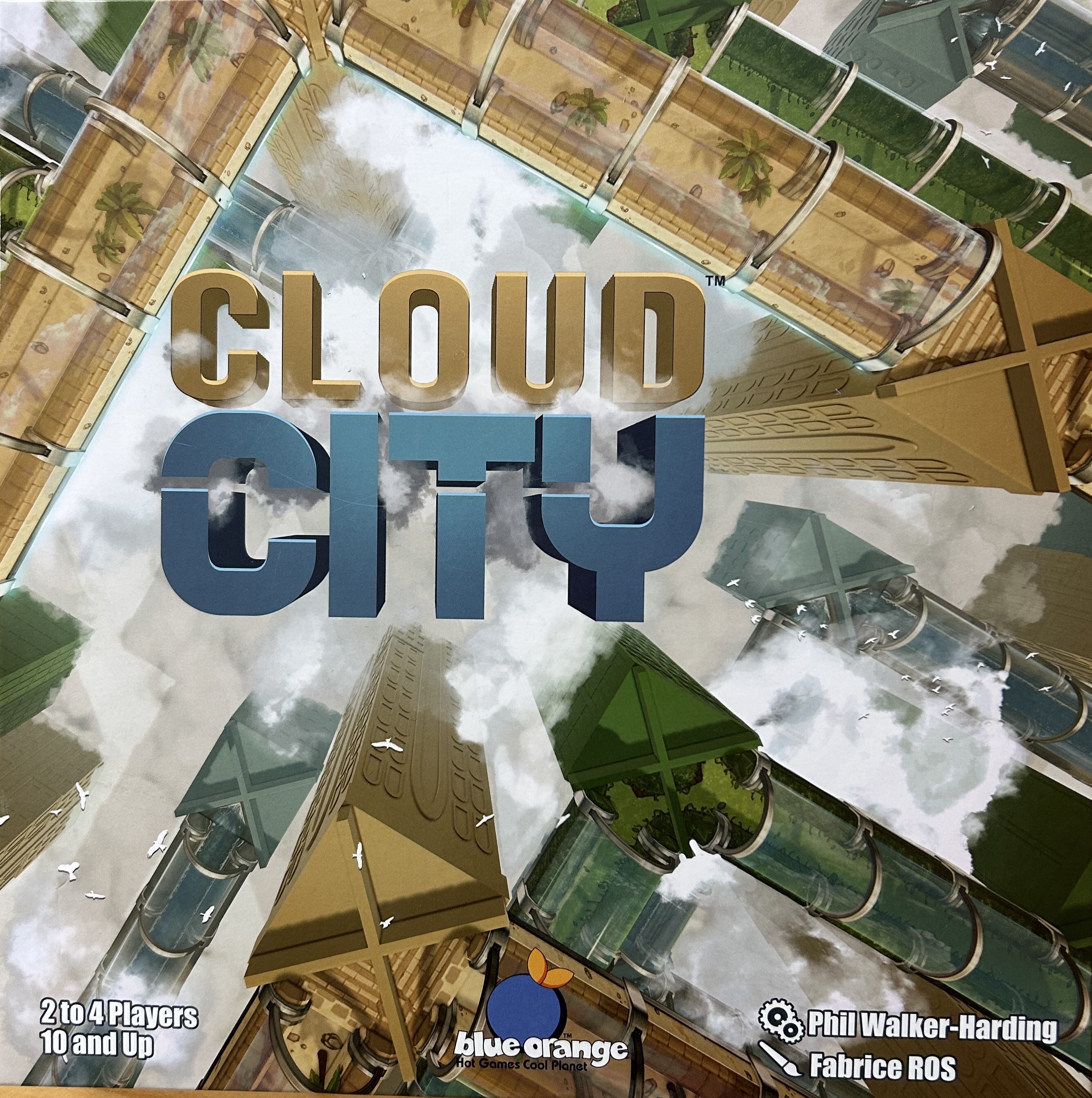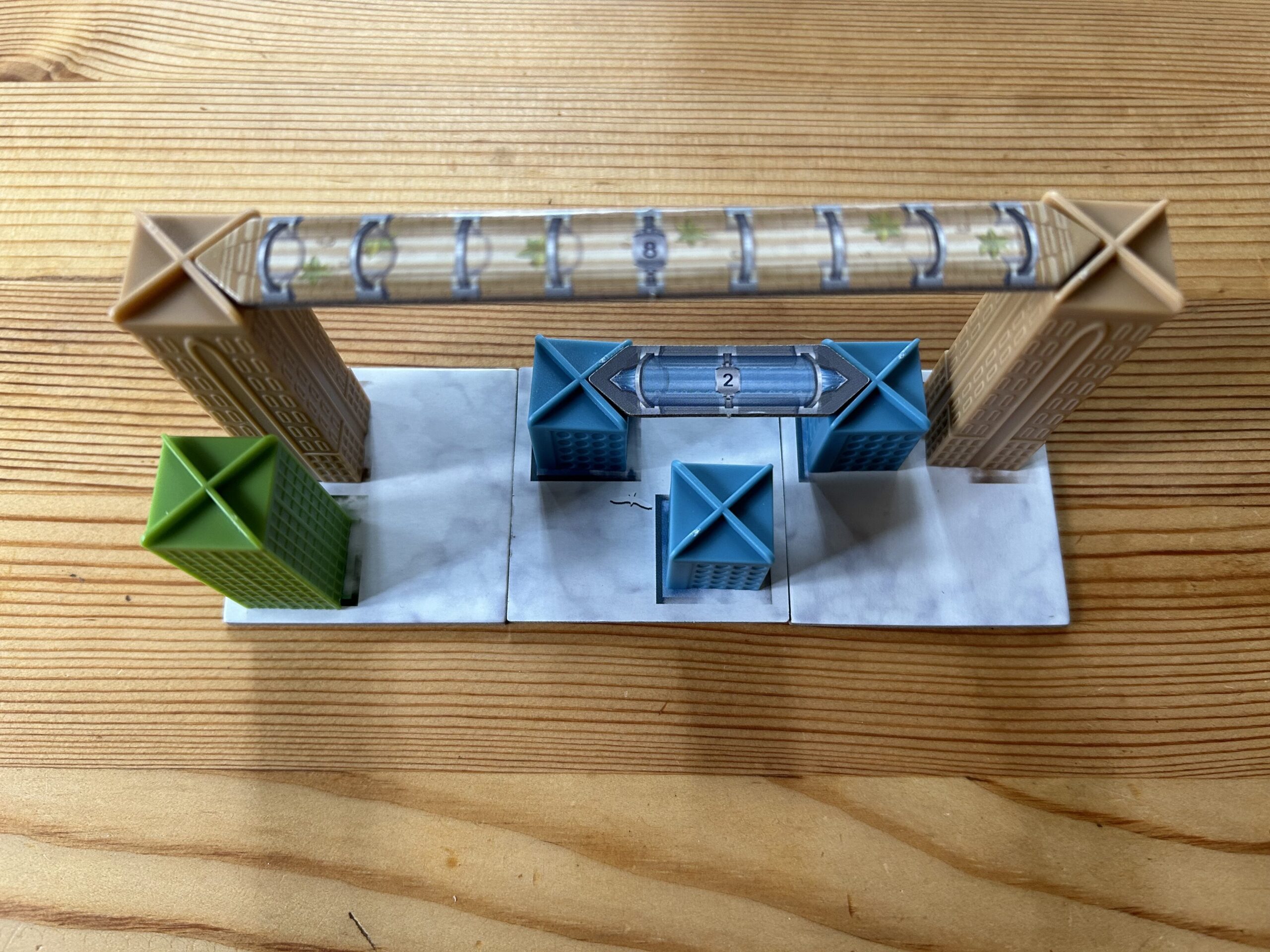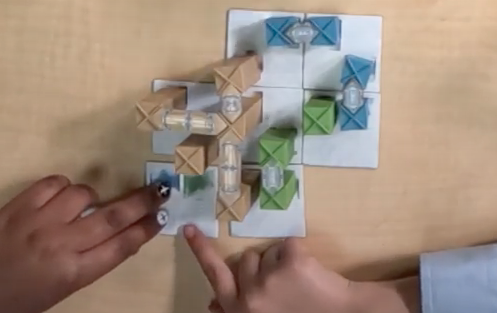
Cloud City has players compete to build the best city plan with towers high in the sky. Players place tiles, build towers with bridges that connects towers of the same height. However, there are a limited number of bridges available and the longer the bridge, the more points it is worth. As the players build their cities in a 3×3 grid, they are encouraged to think strategically to place tiles, visualize how the buildings will interact, and practice rotating and transforming tiles to find the best spot.
How to Play
Pieces:

- 48 Tiles
- 32 Blue towers
- 32 Green towers
- 32 Brown towers
- 31 Blue bridges
- 31 Green bridges
- 31 Brown bridges
Setting up:
Place the towers and bridges within reach of all players. Separate the starting tiles (the tiles with birds in the middle) shuffle the remaining tiles. Each player selects a starting tile and receives 3 tiles for their hand. The rest of the tiles go in the middle and three tiles are placed face up in the middle. Players place buildings of the corresponding colour to the squares on their starting tile.
Playing:

The first player will select a tile from their hand and connect it to their starting tile. Tiles must have at least one side touching another tile (they cannot be placed on a diagonal and only touch with a corner). The buildings must be built immediately, however players can choose to place the bridges immediately or wait. There is strategic advantage to waiting until more tiles are placed for optimal bridge building, but there is a risk that bridges will all be taken if they wait too long.
Once they have played, a new tile is selected from the three face up or at random from the deck so the player has three tiles in their hand. If they select from the deck, a new tile is flipped over and available to the next player. Players take turns until each has completed a 3×3 grid.
Rules for placing tiles and building bridges:
- Tiles must form a 3×3 square at the end of the game.
- Bridges can only be built on the buildings of the same colour.
- A maximum of two bridges can be built on a single tower.
- Bridges can go over smaller buildings but not over towers of the same size or taller.
- Bridges cannot be built over a gap in the grid.
Scoring:
Once all players have completed their grid, it is time to score points. Add up the number of points on the bridges and the player with the highest score wins!
Teaching Resources
Below are resources for you to adapt for your classes. Each lesson plan highlights mathematical processes to focus on, questions for reflection and a worksheet for the students to complete following their game. Holding space for class discussions is encouraged and when possible, include pictures from your students’ game boards to prompt discussion in the class.
Mathematical Processes
Communication [C] : Class discussions and negotiating gameplay with their partner provides authentic opportunity for the students to practice communicating their reasoning. The students utilize words, playing pieces, and gestures to communicate their thinking and hear their peers offering other perspectives.
Connections [CN] : When students play Cloud City, they use their knowledge from the previous games to develop strategies. This allows students to expand their thinking by recognizing patterns from previous games and adapt the approach
Mental Mathematics and Estimation [ME]: Throughout the game students can use mental math to evaluate which option would give them the most points. Students often use estimation to determine what length of bridge will fit in a space.
Problem Solving [PS]: Although players build their own grid, the limited number of bridges and replacement tile selection changing, requires players to pay attention to others and adapt to changing circumstances. They may need to consider building in a different direction or switch strategies when long bridges of one colour run out.
Reasoning [R] : Cloud City encourages reasoning, especially in class discussions and in partnered games. As they examine the board they must make a case for the placement of the tile, the decision to wait or build a bridge and the selection of the replacement tile.
Visualization [V] : The visualization aspect of Cloud City provides learners with an opportunity to imagine how their towers will connect to each other or block possible bridges. Overtime, they begin to develop skills in assessing the length of bridge that is required for the spaces between buildings. Students use their tile manipulatives to visualize possible placements for their tiles.